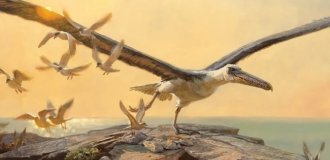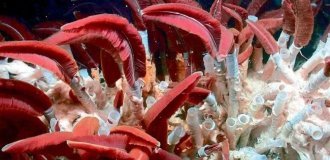The word “megafauna” refers to the totality of all species of animals with an average body weight exceeding 44 kg. However, in fact, the boundaries of the concept are quite arbitrary: for example, some researchers take 100 kg as the lower mass limit, some - 250, but few doubt that the giant eagle from New Zealand or the world famous dodo is also part of the megafauna.
For us, the megafauna of the Pleistocene is of greatest interest. The Pleistocene (1.8 million - 11 thousand years ago, and in fact to this day) is an era in the history of the Earth, marked by several major events: the appearance of Homo sapiens, several periods of severe cold weather and... the extinction of most large animals around the world. This post is dedicated to the giants who disappeared at the end of the Pleistocene era and whom we will now hardly ever see with our own eyes. Here are 30 amazing animals that have disappeared over the past few thousand years, some earlier, and some almost yesterday... Almost all of them were seen by ancient people with their own eyes, and in most cases they had a hand in their rapid extinction.
1. Mammoths, elephants, mastodons

Proboscis, the largest land animals of the Quaternary period, which are landscape-forming animals and the clearest indicator of the health of biocenoses, were distributed on four continents and on many sea islands, and the diversity of their species was unlike today. In our native Eurasia there were the woolly mammoth (genus Mammuthus), the straight-tusked elephant (Palaeoloxodon), the stegodon (Stegodon) and the living Asian elephant. America was inhabited by two types of mammoths - woolly and Columbian, as well as mastodon (Mammut americanum) and gompotherium (Cuvieronius). The current African elephant lived in Africa, and even earlier, in the early Pleistocene, several more species, including the Asian one. Elephants that moved to isolated islands eventually became... dwarf; this happened with the stegodons of the Flores and Sulawesi islands (Indonesia), the mammoths of the Wrangel Island (Russia) and the Channel Islands (USA), the elephants of the Mediterranean islands (Corsica, Sardinia, Sicily, Cyprus, Malta, Crete and several more Greek islands). The height of these elephants sometimes barely reached 1 m...
There is still much that is unclear about the disappearance of the great variety of proboscideans; Thus, there are still discussions about the reasons for the extinction of mammoths in Siberia and the Arctic. The activity of two factors is undoubted - climate change and active hunting by ancient people. Different species of elephants on different continents disappeared at different times, respectively: American - 8-10 thousand years ago, Eurasian - a little earlier. Pygmy elephants survived until the beginning of the Holocene (on the Greek island of Tilos - until about 2000 BC), the mammoths of Wrangel Island died out a little earlier; the last representative of the gompotherians, Cuvieronius, disappeared from South America presumably by 400 AD.
2. Rhinos

The woolly rhinoceros (Coelodonta antiquitatis) is the second most famous Pleistocene animal after the mammoth. Its length reached 3.5 m, weight - up to 3 tons. It had two horns on its muzzle, the longest of which, the front one, sometimes reached more than 1 m in length. An important feature of this species is its long, thick, brown hair, similar to that of a mammoth, which allowed the rhinoceros to survive in northern and central Eurasia, which is inhospitable for heat-loving animals. The woolly rhinoceros lived on cold plains called “mammoth steppes” - in their place now there are rustling coniferous and broad-leaved forests. The species became extinct about 10 thousand years ago, and possibly later. As in the case of mammoths, there are two main hypotheses for the disappearance of northern rhinoceroses: sudden climate change and excessive hunting by ancient humans. Most likely, both factors affected...
Much less known are two other possible contemporaries of ancient people - Elasmotherium (3-4 species) and Merk's rhinoceros (Dicerorhinus kirchbergensis). Elasmotherium was truly a gigantic beast: its height at the withers reached 2.3 m, and its weight reached 6 tons! It had only one horn on its head, but it could supposedly reach up to two meters in length. Merc's rhinoceros was similar in size to the woolly one and also had two horns. Both of these animals died out before the woolly rhinoceros - perhaps unable to withstand competition with it; however, a number of researchers are confident that relict populations of Elasmotherium and Merck’s rhinoceroses survived until the very end of the Pleistocene and met with ancient people.
3. Bulls

Over the past 10 thousand years, the bovine subfamily (Bovinae) has lost several very interesting and sometimes very colorful species. North America and Eurasia lost several species of bison at once, the most famous of which is the steppe bison (Bison priscus), which lived on both sides of the Atlantic and became extinct about 6 thousand years ago. Even in Africa, where the extinction of large animals was not widespread, only 4 thousand years ago the huge long-horned buffalo Pelorovis antiquus disappeared. Several species of bovines, notably the Baikal yak (Poephagus baicalensis) and the Philippine pygmy buffalo (Bubalus cebuensis), have become extinct in Asia. But the most famous species of extinct bull, of course, is the aurochs (Bos primigenius) - a wild bull from Europe and Asia, which became the progenitor of most breeds of cattle. This powerful black animal with a light stripe on its back completely disappeared by 1627.
One of the main reasons for such a sharp decline in the number of wild bull species (and the decline in the numbers of many surviving species) is active persecution by people; Scenes of hunting bulls and bison often appear in rock paintings. In addition, the climatic factor has a great influence on the reduction in the number of large bovid ungulates, especially in northern latitudes.
4. Cave bear

The cave bear (Ursus spelaeus) is another animal extinct under human control, well known in wide circles that are far from paleontology and archeology. It was found in Europe - Western (larger variety, up to 3.5 m in length) and Eastern (no more brown). The cave bear gravitated primarily to open spaces rather than forests, as well as caves. Another important difference: while the brown bear is a classic omnivore with a bias towards herbivory, the cave bear was almost a complete vegetarian. Therefore, for ancient people, only the strength and size of this animal could pose a danger: it is unlikely that this type of bear ever specifically hunted people.
The cave bear disappeared about 10 thousand years ago, and perhaps a little later. The most likely reason for its extinction is this: following the end of the last ice age, the forest-steppe zone quickly became covered with dense forests, depriving the bear of its usual habitat; individuals who chose caves as shelters were killed by people. In addition, the latter hunted for terrifying, but not too dangerous giants: meat and a warm bear coat were good trophies.
5. Arctodus

Two species of long-legged, short-faced bears that lived in North America. Unlike the relatively clumsy and omnivorous brown, black and cave bears, the giant flat-faced bear (Russian name for the larger species Arctodus simus) was a true predator and active hunter, capable of catching up and killing very large prey, including elk, camels, bison and young mammoths - the same way modern lions do. Its dimensions were appropriate: height at the withers - 1.6 m, height when standing on its hind legs - more than 3 m, and weight - up to a ton.
Arctodus disappeared approximately 10-12 thousand years ago, along with other representatives of the megafauna of Pleistocene America. Possible reasons: competition with a brown bear (which is unlikely: Arctodus was much stronger, and in open spaces the brown had no chance at all - either in the success of the hunt or in a one-on-one fight) or a sharp reduction in the food supply due to climatic or ( i) anthropogenic factors (which is already more likely).
6. Lions

The modern range of the lion (Panthera leo) is limited to sub-Saharan Africa and a tiny reserve in India. This is only a small part of the original range of the lion - more precisely, several of its subspecies, and possibly species: the cave lion (P. l. spelaea) was found in Eurasia - from England to Siberia and Turkmenistan, Vereshchagin's lion (P. l. vereshchagini) - from Yakutia to Alaska, the American lion (P. l. atrox) inhabited America - from Alaska in the north to Peru in the south. Two more subspecies of lions (Barbary and Asian) lived in Europe and Central Asia.
The most well known are the cave lion and the American lion. We don’t know exactly what they looked like; Presumably their coloring was paler, very likely with spots or stripes. The presence of a mane in males is disputed (my personal opinion is that there was a mane, it was warmer with it). The linear dimensions were superior to African lions: the American subspecies was the size of the Amur tiger and even larger.
All lions were active hunters and apex predators of their biomes; only the American lion was inferior in size and strength to the flat-faced bear. Their prey included all kinds of ungulates, which roamed the steppes and woodlands of the Palaearctic in herds of millions.
The American and cave lions disappeared about 10 thousand years ago; individual populations could survive into ancient times. The likely causes of extinction are famine due to a sharp reduction in the number of prey; active competition with humans; a combination of climatic and anthropogenic factors... The Barbary lion was exterminated in the wild by 1922; The Asiatic lion survives only in India (the population size is about 300 individuals) and in several zoos around the world.
7. Saber-toothed cats

True saber-toothed cats (Machairodontinae) are a subfamily of large felid predators highly specialized in preying on thick-skinned herbivores such as bulls, giant sloths and elephants. In the general public they are known as saber-toothed tigers, however, morphologically these animals are not related to the tiger species (Panthera tigris), but are directly related to cats. The main differences between saber-tooths and modern large cats are a short tail and a unique jaw apparatus: the upper fangs were gigantic in size (up to 17 cm), and the lower jaw could open so widely relative to the upper that it made an angle of 120° with it.
At least two genera of saber-tooths survived into the late Pleistocene: Smilodon and Homotherium. Smilodon, a classic saber-toothed tiger, was the size of a large lion (height at the withers - up to 1.2 m, weight - up to 300 kg) and lived in North and South America. Homotherium was slightly smaller; It is distinguished from Smilodon by relatively short fangs and a lighter build. He lived in Africa, Eurasia and North America.
The last saber-toothed cats disappeared in North America 8-10 thousand years ago, and in Eurasia and Africa even earlier. The reasons for the extinction of these strong and dangerous predators are not completely clear, but three versions are obvious: fierce competition with real cats (lion, tiger, jaguar, etc.), climate change and pressure from humans. Most likely, the combination of these three factors became fatal.
8. American cheetahs

At least two species of large North American cats (genus Miracinonyx), morphologically very similar to the African cheetah, but genetically closer to the puma. Unlike the vast majority of other megafauna, Miracinonyx is known only from skeletal fragments, so much about its biology still remains unclear. However, it is known that in appearance this interesting animal was very reminiscent of modern cheetahs and hunted in the same way, catching up with prey in a sprint. As proof of this fact, the pronghorn antelope now living in North America can reach speeds of up to 100 km/h. None of the modern American predators can run at such speed, which means only one thing - quite recently there was a fleet-footed predator, to escape from which it was necessary to develop speed skills. This predator was the American cheetah - there are no other contenders for this. And it died out relatively recently - 10-13 thousand years ago.
9. Deer

Today there are many species of deer; however, much of the original diversity of these beautiful animals disappeared during the Pleistocene and early Holocene. Here are some of them: the largest and most famous is the big-horned deer (Megaloceros giganteus) from Europe, northern Africa and northwest Asia, a majestic animal up to 2.1 m tall at the withers, 3 m long, with huge beautiful horns spanning up to 3 ,6 m. Two genera of its closest relatives - Praemegaceros and Sinomegaceros - were found by the end of the Pleistocene on the island of Sicily and in East Asia, respectively. On both sides of the Atlantic lived a huge Cervalces, the size of a large elk; In North America, there were deer from the genera Navahoceros and Sangamona - medium-sized, similar to reindeer.
The disappearance of several genera of large and giant deer happened 9-12 thousand years ago, some species became extinct even later. Probable reasons are global climate change, pressure from people and competition with surviving species of deer and elk.
10. Dire Wolf

At the time of its settlement by humans, North America was inhabited not only by the well-known gray wolf. Hundreds of thousands of years ago, a species appeared on the continent that people would later call the dire wolf (Canis dirus). It was larger and more massive than the gray wolf (1.5 m in length, weighing up to 80 kg), and was distinguished by shorter paws and larger teeth. It was a pack predator that hunted very large animals such as horses and bison.
The dire wolf disappeared about 10 thousand years ago - just when the mass extinction of large animals in North America, which served as food for huge canines, began. The last population of the species probably survived until the 2nd millennium BC. in the Ozark Mountains (Arkansas, USA).
The remains of the dire wolf are the most widespread finds in the tar traps of Rancho La Brea (California): more than three thousand skeletons of this beast were found there.
11. Giant beavers

The modern beaver is one of the largest rodents of our time. If his distant North American relative had survived to this day, he would undoubtedly have become an absolute record holder: the length of the American giant beaver (Castoroides ohioensis) reached 2.5 m, and its weight - up to 220 kg! In addition to its size, the giant beaver differed from the usual in its narrower tail, similar to the tail of a muskrat, and huge teeth protruding from the gums by almost 15 cm. We can only guess about the lifestyle of the giant beaver. He could have been either a diligent builder (like his smaller relative) or living in open areas along the banks of large rivers and lakes, possibly in near-water burrows.
The gigantic rodent disappeared about 9.5 thousand years ago, presumably due to the reduction of its habitual habitats and persecution by humans.
In Pleistocene Europe, there lived another genus of giant beavers - Trogontherium, but it died out much earlier and, perhaps, never intersected with people.
12. Long-legged peccaries

Two genera of small pigs, close relatives of modern peccaries. They were distinguished by their larger sizes (a meter or more in length) and long legs, thanks to which the animals were good runners. The genus Platygonus was distinguished by a shortened snout with large and sharp fangs, which served as a good means of defense against predators. The larger Mylohyus (up to 90 cm tall!), on the contrary, had a long, elongated facial part of the head, reminiscent of the giant predatory pigs Entelodons that died out many millions of years ago. Long-legged peccaries lived in North America, probably moving across prairies and woodlands in small groups, like antelopes.
Giant peccaries, like many other members of the North American megafauna, disappeared about 9-12 thousand years ago.
13. Marsupial lion

The largest marsupial predator in Australia, reaching the size of a modern jaguar: length from the tip of the muzzle to the base of the tail - 110 cm, height at the withers - 70 cm, weight - 100 kg or more. The jaws of the marsupial lion (Thylacoleo carnifex) had the same bite force as a lion's, and its powerful muscles testify to the enormous strength of this beast, undoubtedly capable of felling the largest herbivores on the continent - such as diprotodons and giant kangaroos. The skeletal details of the marsupial lion suggest that the animal could sit on its hind legs, supported by a strong tail, like a kangaroo, and climb trees like a leopard.
The marsupial lion disappeared 30-40 thousand years ago, at the same time as the rest of the Australian megafauna. Rumors that he could have survived into historical times still haunt the minds of cryptozoologists, who cherish the hope of finding the mysterious “Queensland tiger cat.” But the chances of enthusiasts getting lucky are now practically zero...
14. Diprotodon

Diprotodon, or “marsupial hippopotamus” (genus Diprotodon) is a huge herbivore from Australia, the largest individuals of which reached 3 m in length and 1.8 m in height. It is sometimes called the giant wombat, and for good reason - the wombat is the closest relative of living marsupials. It lived in open grass pastures and woodlands, most likely not far from water bodies.
Diprotodon disappeared towards the end of the Pleistocene; Regarding the exact date of extinction of the “marsupial hippopotamuses”, different sources give different information - from 50 to 18 thousand years ago. However, all these figures may be wrong if the legends about the bunyip, the Australian semi-aquatic “demon”, are not completely fictitious; in this case, the last diprotodons became extinct in historical time. The main reasons for the disappearance of huge marsupials are sudden climate changes and the active activity of Australian aborigines.
15. Megaladapis

Three species of huge lemurs from Madagascar. Adult Megaladapis edwardsi were the size of a large orangutan, and their skull with powerful jaws reached a length of 30 cm. However, the structure of the teeth proves that these animals were herbivores and led approximately the same lifestyle as modern koalas. Megaladapis existed for quite a long time and became extinct about 500 years ago due to active hunting and deforestation.
There were several other genera of giant lemurs. They were very diverse: for example, the huge Archaeoindris fontoynonti weighed about 180 kg and occupied an ecological niche in Madagascar close to the South American ground sloths. Another species, Palaeopropithecus ingens, was the size of a chimpanzee and lived in trees, where it ate succulent fruits and leaves. Like Megaladapis, it became extinct in historical times.
16. Steller's cow

A giant relative of modern manatees. Length - about 8, and probably up to 10 meters; weight - up to 4 tons. Color - from dark to gray-brown. There were no teeth; they were replaced by well-developed horny plates. The animals ate algae.
Once living in the shallow waters of the entire northern Pacific, this clumsy and extremely defenseless mammal was found only near the Commander Islands at the time of its discovery by the Bering expedition (1741). Intensive hunting of the sea cow for its meat, skin and fat led to its complete extinction by 1768: it took only 27 years for humans to exterminate an entire species of large marine mammals. The reduction in the original range is also associated with active human activity: it reached Japan, Alaska and California earlier than the Commander Islands, remote from the mainland.
17. Ground sloths

Several genera of giant ground sloths survived before humans arrived in the New World. The largest of them, Eremotherium, reached a length of 6 meters and a weight of 3 tons! These strange animals lived, presumably, in open spaces - in the savannas and woodlands of South America, southern North America and the islands of the Caribbean Sea; ate plant foods. An adult Eremotherium was practically invulnerable to predators: the skin of ground sloths contained small bone plaques, which together made up a kind of chain mail; therefore, it was extremely difficult to pierce the skin of a sloth - both with the fangs of a saber tooth and with a human spear. And the huge claws on the front paws were such a terrible weapon that if an enemy approached too close a distance, the eremotherium itself became a dangerous enemy.
In addition to the indicated 6-meter giant, several smaller species survived until the late Pleistocene - in particular, Nototheriops, Glossotherium, Megalonyx and Mylodon. These animals were approximately the size of a cow and weighed 150-300 kg.
Ground sloths disappeared at the same time as all American megafauna - approximately 10 thousand years ago. There is reason to believe that individual populations of ground sloths from Haiti, Cuba and Patagonia could have survived into historical times.
18. Giant armadillos

The family of armadillos, distant relatives of sloths, now includes about 20 species of small animals that resemble a cross between a pig and a turtle, but are more similar in lifestyle to hedgehogs. However, more recently, the territory from Patagonia in the south to the southern United States in the north was inhabited by armadillos that were not inferior in size to the largest local predators. Glyptodon clavipes, the most famous of them, reached a length of 3 m, and Doedicurus clavicaudatus, the largest - 3.6 m and was armed with a bone club with spikes on the tail, exactly like the ankylosaurs that disappeared 65 million years ago . These giants were clumsy herbivorous creatures, reliably protected from the dangerous fangs of saber-tooths and the powerful beaks of the fororakos, which disappeared a little earlier.
Giant armadillos became extinct 10-11 thousand years ago, most likely due to pressure from more terrible predators that came from the north (there is strong evidence of hunting glyptodonts by humans and jaguars). Most likely, climate change also affected their population.
In addition to the glyptodont and doedicurus, two more species of extinct armadillos are worthy of mention - the Texas glyptotherium texanum, 1.8 m long, and the beautiful armadillo (Dasypus bellus, up to a meter long). Both species disappeared at the same time as their gigantic relatives.
19. Macrauchenia

An amazing mammal from South America that looked like a camel or a llama, but was not related to them. It belonged to the now completely extinct order of Litopterna, distantly related to ungulates. Macrauchenia patagonica was about two meters tall and weighed more than a ton; The animal was distinguished by a relatively long neck, a wide foot with three supporting toes with something like hooves, and a small proboscis, with the help of which Macrauchenia tore off leaves and grass in the savannas and woodlands of Pleistocene America.
Macrauchenia became extinct at the end of the Pleistocene - 10-20 thousand years ago. Possible reasons are climate change, active persecution by the first Americans and displacement by North American animals that gradually colonized the southern continent.
20. Toxodon

Toxodon platensis is one of the last representatives of another order that has completely disappeared by now - Notoungulata, related to ungulates. It was the South American equivalent of hippopotamuses and rhinoceroses: up to 3 m in length, 1.5 m at the withers and weighing a ton. One of the largest Pleistocene animals on the continent, Toxodon was a herbivorous animal that may have gravitated to the shores of water bodies. Apparently, this was the favorite prey of Smilodon; The scene of saber-tooth hunting for Toxodon was shown in the popular science fiction film “Prehistoric Park”.
The giant ungulates of South America disappeared at the end of the Pleistocene era. Probably, a combination of a number of factors is to blame for their extinction - climatic, anthropogenic, as well as interaction with the North American fauna, which gradually replaced its original inhabitants on the southern continent.
21. Teratorns

Huge American vultures, related to modern condors. The wingspan of the largest of them, Argentavis, could reach 8 meters - this is a record among flying birds. However, Argentavis lived in the Miocene and therefore could not meet with people; in the Pleistocene, its smaller relatives from the genera Teratornis and Aiolornis lived. But they are relatively small: their wingspan is 3.5 and 5 m, respectively. The lifestyle of teratorns was the same as that of modern vultures and condors, only with the difference that they fed primarily on the corpses of not antelopes and bison, but various thick-skinned giants - such as elephants and giant sloths.
Tetatornas became extinct exactly at the time when the entire American megafauna collapsed - about 10 thousand years ago, following the disappearance of their food supply.
22. Haast's Eagle

Haast's eagle (Harpagornis moorei) is the largest eagle ever to exist, the apex predator of the bird paradise on Earth - New Zealand during the late Pleistocene. Its wingspan was about 3 meters, its weight was up to 15 kg. A giant eagle was hunting large, flightless moa; and he died out along with them - around 1500 AD, left without his usual food and persecuted by the Maori as potentially dangerous to humans.
In addition to the Haast's eagle, the giant harrier (Circus eylesi), the size of a small eagle, was also found in New Zealand. Explorer Charles Douglas in the 1870s. shot two very large birds of prey, not typical for the fauna of New Zealand. Presumably these were the last individuals of Eiles' harrier: the likelihood that Haast's eagle, feeding on prey of its size, could have survived until the end of the 19th century is close to zero.
23. Ornimegalonyx

Ornimegalonyx oteroi is a huge (about 1 m tall, weight 8-9 kg), poorly flying owl from the island of Cuba. When its bones were first found in 1954, the species was described as a member of the Fororakos family - the remains were too large. Only 11 years later, a more detailed study of these bones showed that they belonged to the largest owl that ever lived on the planet.
This amazing bird lived at the end of the Pleistocene and died out 10-8 thousand years ago. The reasons for this sad event are not known for certain.
24. Moa

More than 10 species of large, ostrich-like flightless birds found on both islands of New Zealand. Some of them were no larger than a modern emu, but representatives of the genus Dinornis (D. robustus and D. novaezelandiae) reached a height of 3.6 m and weighed a quarter of a ton. In the unique environment of New Zealand, which knew no mammals (except for three species of bats, one of which became extinct in 1965), moas occupied the ecological niche of large ungulates.
The number of moa began to decline steadily after the arrival of the first settlers on the island - the Polynesians, who gave rise to the Maori tribe. People actively hunted these not too fast and stupid birds, and as a result, the last representatives of the family (the species Megalapteryx didinus) became extinct around the 16th-18th centuries. AD
25. Epiornis

Epiornis (Aepyornis) - Madagascar analogues of moa. About a dozen species of huge flightless birds, the largest of which were over 3 m tall and weighed 500 kg (a record among birds in general!). The epiornis egg was up to 35 cm long, and its volume was like 160 chicken eggs.
Before the settlement of Madagascar by people, apiornis had no serious enemies - perhaps with the exception of crocodiles. Around the 16th century, “elephant birds” repeated the fate of the New Zealand ratite giants: all that remained were bones, fragments of huge eggs and folk tales.
26. Geniornis

Genyornis newtoni is the last member of the unique family Dromornithidae, ostrich-like flightless birds related to modern Anseriformes. His height is 2 m, weight is 200-240 kg. Lived in the forests and steppes of Australia 1600 - 30 thousand years ago. Most likely he was a herbivore.
These amazing birds disappeared about 40 thousand years ago, some time after people settled the mainland. The remains of Geniornis were found next to human tools, which proves the fact of encounters between Australian aborigines and huge birds. It is likely that it was human activity that led to the extinction of the last giant Anseriformes; however, it is too early to exclude the climate version.
27. Megalania

A huge Australian monitor lizard 5-7 meters long. Presumably a relative of the Komodo dragon, which is considered the largest lizard of our times (length - 3-4 meters), however, due to several significant differences, it is separated into a separate genus Megalania. An active predator that attacked everything it could defeat - that is, almost any animal it encountered that could not run away or hide under its shell.
Megalania became extinct about 40 thousand years ago - precisely at the time when the first people arrived on the continent. There is no doubt that for them the giant monitor lizard was one of the most terrible enemies, as well as a competitor for food resources. However, there is no direct evidence of deliberate human hunting for megalania.
28. Land crocodiles

All modern crocodiles are semi-aquatic reptiles and cannot survive for long without bodies of water, where they spend almost their entire lives. However, this is not the only life form of these dangerous armored predators. At least four genera of land running crocodiles survived into the Pleistocene - Quinkana, Pallimnarchus, Volia and Mekosuchus. The first two genera are found in Australia; the latter lived on the islands of the South Pacific, such as Fiji, Vanuatu and New Caledonia. They were distinguished from modern crocodiles by a lifestyle reminiscent of modern monitor lizards; the jaws were just as powerful and sometimes looked like butcher knives. Some species may have preferred to feed on coastal shellfish. The size of land crocodiles is not great - 2-3 meters in length; in the Pliocene, 7-meter forms were also found.
The last land-based crocodiles (genus Mekosuchus) disappeared already in historical time, around 400 AD. - just when man arrived in New Caledonia. Australian species became extinct even earlier - about 40 thousand years ago, and perhaps a little later.
29. Meiolania

Meiolania platyceps, a huge land turtle from the late Pleistocene of Australia, reached a length of 2.5 m and weighed 900 kg or more. Its head was decorated with powerful horns, the distance between the tips of which was 60 cm, and its long tail (a rare phenomenon for turtles in general) was armed with armored rings and spikes. These dangerous tools were intended to protect the animal from predators. Meiolania itself was most likely herbivorous.
There were several other species of meiolania, but they were all smaller in size and not as well armed. Horned turtles disappeared at the end of the Pleistocene, which was marked in Australia by serious climatic changes and the settlement of the continent by people. The last meiolania escaped on Lord Howe Island, but soon after its discovery by man, all that remained of these amazing reptiles were bones and memories.
30. Baiji

The Chinese river dolphin, or baiji (Lipotes vexillifer) is still a living (?) illustration of the statement that the extinction of megafauna cannot be considered a completed process. Its average length is about 2 m, weight is about 200 kg. Found only in the Yangtze River basin, it is the only freshwater dolphin in the world capable of living in a freezing river.
The number of this species of freshwater dolphins, which received a scientific description only at the beginning of the 20th century, has been steadily declining: anthropogenic factors have played a role - excessive hunting, noise and industrial-chemical pollution of the Yangtze, predatory fishing, and the construction of large dams and dams. However, no active measures were taken to save the unique animal. In August of this year, news sites reported that the baiji had finally become extinct, but just a couple of weeks later a refutation came from China - a video of a large white animal splashing in the waters of the Yangtze. Bottom line: now the number of baiji is just a few individuals, and their number is hardly enough to revive a relatively stable population. The oxymoron “living corpse” received its visual personification by a whole species of large mammals...
This is not a complete list of representatives of that diverse fauna, full of amazing creatures, native to the planet, who have received the not entirely deserved prefix mega-, that have passed into oblivion. Animals that we consider giants have existed in the history of the Earth since the Paleozoic: Devonian (and not only) fish and shellfish, Carboniferous amphibians and invertebrates, Permian-Mesozoic reptiles, Cenozoic mammals and birds. With the emergence of a superpredator called Homo sapiens into the arena of evolution, the fauna of the late Cenozoic had to thin out considerably so that the endless expanses of all habitable continents and islands could be populated by millions and billions of individuals of just one, but the most progressive and - unfortunately - the most vicious looking.





















